
Hylidae is a wide-ranging family of frogs commonly referred to as "tree frogs and their allies". However, the hylids include a diversity of frog species, many of which do not live in trees, but are terrestrial or semiaquatic.
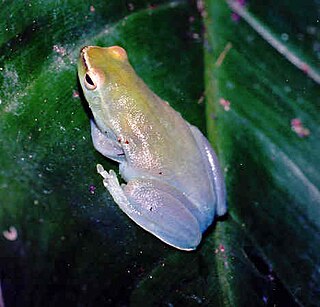
Sphaenorhynchus is a genus of frogs in the family Hylidae. They are also known as lime treefrogs or hatchet-faced treefrogs. They are found in the Amazon and Orinoco River basins of South America, the Guianas, Trinidad, and southern and eastern Brazil. The majority of the species are associated with the Atlantic Forest domain in Brazil.

Cruziohyla is a genus of frogs in the subfamily Phyllomedusinae. They occur from Honduras in Central America south to the Amazon Basin in South America. This genus was erected in 2005 following a major revision of the Hylidae and fully reviewed in 2018. Species in this genus were previously placed in the genera Agalychnis or Phyllomedusa.

Bokermannohyla is a genus of frogs in the family Hylidae. It was erected in 2005 following a major revision of the Hylidae. Twenty-three species previously placed in the genus Hyla were moved to this genus named in honor of Werner Carlos Augusto Bokermann, Brazilian herpetologist. The genus is endemic to southern Brazil.
Bromeliohyla, sometimes known as the bromeliad treefrogs, is a genus of frogs in the family Hylidae. This genus was erected in 2022 following a major revision of the Hylidae. The original two species in this genus were previously placed in the genus Hyla. It is the former Hyla bromeliacea group identified in a genetic study by Duellman (1970). Frogs in the genus are found in tropical southern Mexico, Belize, Guatemala, and northern Honduras.

Dendropsophus is a genus of frogs in the family Hylidae. They are distributed in Central and South America, from southern Mexico to northern Argentina and Uruguay. They are sometimes known under the common name Fitzinger neotropical treefrogs or yellow treefrogs

Boana is a genus of frogs in the family Hylidae. They are commonly known as gladiator frogs, gladiator treefrogs or Wagler Neotropical treefrogs. These frogs are distributed in the tropical Central and South America from Nicaragua to Argentina, as well as in the Caribbean.

Bokermannohyla izecksohni, also known as Izecksohn's treefrog, is a species of frog in the family Hylidae. It is endemic to São Paulo state, Brazil. It was already considered possibly extinct in 2004, but three living frogs were discovered in 2005–2006. It is a medium-sized treefrog, measuring about 45 mm (1.8 in) in snout–vent length.

Itapotihyla is a genus of frogs in the family Hylidae. It is monotypic, being represented by the single species Itapotihyla langsdorffii, commonly known as the ocellated treefrog. It is found in the Atlantic Forest biome of Brazil, with an isolated population in eastern Paraguay and adjacent Brazil and northeastern Argentina.
Bokermannohyla diamantina is a species of frogs in the family Hylidae. It is endemic to Brazil.
Bokermannohyla itapoty is a species of frogs in the family Hylidae. It is endemic to the state of Bahia in northeastern Brazil. It is closely related to Bokermannohyla alvarengai. The specific name itapoty refers to the dorsal coloration that gives this frog a lichen-like resemblance. The name is derived from the Tupi–Guarani words itá (="rock") and poty, meaning lichen or moss.
Bokermannohyla oxente is a species of frogs in the family Hylidae. It is endemic to Bahia state, Brazil.
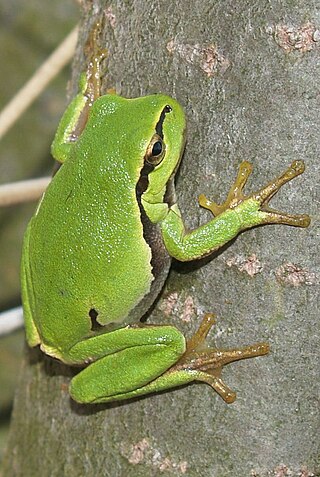
Hylinae is a large subfamily of "tree frogs", family Hylidae.
Boana caipora is a frog in the family Hylidae. It is endemic to Brazil. Scientists have seen it 700 to 800 meters above sea level in Atlantic forest.
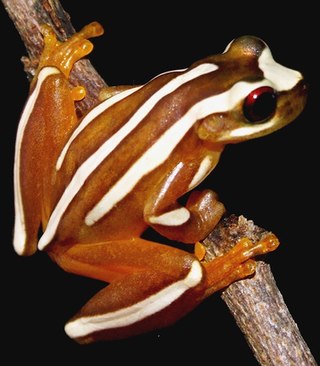
Dendropsophus nekronastes is a frog in the family Hylidae. It is endemic to South America. Scientists know it solely from its type locality in Bahia, Brazil, 303 meters above sea level.

Bokermannohyla capra is a frog in the family Hylidae. It is endemic to the Atlantic forests in Bahia, Brazil.
Dendropsophus ozzyi is a frog in the family Hylidae. It is endemic to in Brazil.
Bokermannohyla flavopicta is a frog in the family Hylidae endemic to southeastern Brazil. Scientists have seen it exclusively over 1500 meters above sea level.
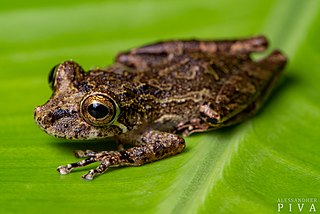
Ololygon is a genus of frogs in the family Hylidae. The majority of species in it are endemic to the Atlantic Forest of eastern Brazil, although the range of some species, including Ololygon aromothyella and Ololygon berthae, is known to extend south to northeastern Argentina, southern Paraguay, and Uruguay.
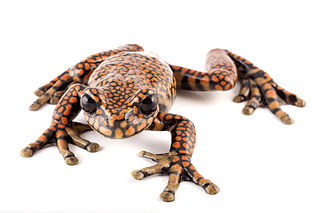
Cophomantini is a tribe of frogs in the subfamily Hylinae of the family Hylidae, the true treefrogs.












